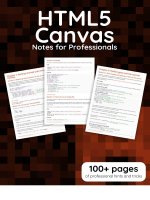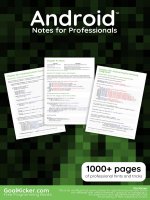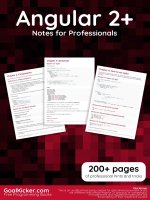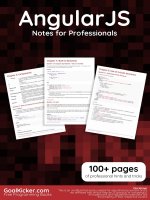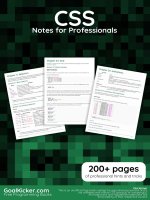Angular2 notes for professionals
Bạn đang xem bản rút gọn của tài liệu. Xem và tải ngay bản đầy đủ của tài liệu tại đây (1.72 MB, 232 trang )
Angular 2+
Angular 2+
Notes for Professionals
Notes for Professionals
200+ pages
of professional hints and tricks
GoalKicker.com
Free Programming Books
Disclaimer
This is an unocial free book created for educational purposes and is
not aliated with ocial Angular 2+ group(s) or company(s).
All trademarks and registered trademarks are
the property of their respective owners
Contents
About ................................................................................................................................................................................... 1
Chapter 1: Getting started with Angular 2+ ..................................................................................................... 2
Section 1.1: Getting started with Angular 2 with node.js/expressjs backend (http example included) ................. 2
Section 1.2: Install angular2 with angular-cli .............................................................................................................. 7
Section 1.3: Getting started with Angular 2 without angular-cli .............................................................................. 10
Section 1.4: Getting through that pesky company proxy ........................................................................................ 14
Section 1.5: Keeping Visual Studios in sync with NPM and NODE Updates .......................................................... 15
Section 1.6: Let's dive into Angular 4! ......................................................................................................................... 16
Chapter 2: Components ........................................................................................................................................... 20
Section 2.1: A simple component ............................................................................................................................... 20
Section 2.2: Templates & Styles ................................................................................................................................. 20
Section 2.3: Testing a Component ............................................................................................................................. 21
Section 2.4: Nesting components .............................................................................................................................. 22
Chapter 3: Component interactions .................................................................................................................. 24
Section 3.1: Pass data from parent to child with input binding ............................................................................... 24
Section 3.2: Parent - Child interaction using @Input & @Output properties ........................................................ 30
Section 3.3: Parent - Child interaction using ViewChild ........................................................................................... 31
Section 3.4: Bidirectional parent-child interaction through a service .................................................................... 32
Chapter 4: Directives ................................................................................................................................................ 35
Section 4.1: *ngFor ....................................................................................................................................................... 35
Section 4.2: Attribute directive ................................................................................................................................... 36
Section 4.3: Component is a directive with template .............................................................................................. 36
Section 4.4: Structural directives ............................................................................................................................... 36
Section 4.5: Custom directive ..................................................................................................................................... 36
Section 4.6: Copy to Clipboard directive ................................................................................................................... 36
Section 4.7: Testing a custom directive ..................................................................................................................... 38
Chapter 5: Page title ................................................................................................................................................. 40
Section 5.1: changing the page title ........................................................................................................................... 40
Chapter 6: Templates ............................................................................................................................................... 41
Section 6.1: Angular 2 Templates ............................................................................................................................... 41
Chapter 7: Commonly built-in directives and services ............................................................................ 42
Section 7.1: Location Class .......................................................................................................................................... 42
Section 7.2: AsyncPipe ................................................................................................................................................ 42
Section 7.3: Displaying current Angular 2 version used in your project ................................................................ 43
Section 7.4: Currency Pipe .......................................................................................................................................... 43
Chapter 8: Directives & components : @Input @Output ........................................................................ 44
Section 8.1: Angular 2 @Input and @Output in a nested component ................................................................... 44
Section 8.2: Input example ......................................................................................................................................... 45
Section 8.3: Angular 2 @Input with asynchronous data ......................................................................................... 46
Chapter 9: Attribute directives to aect the value of properties on the host node by
using the @HostBinding decorator. .................................................................................................................. 48
Section 9.1: @HostBinding .......................................................................................................................................... 48
Chapter 10: How to Use ngif .................................................................................................................................. 49
Section 10.1: To run a function at the start or end of *ngFor loop Using *ngIf ...................................................... 49
Section 10.2: Display a loading message .................................................................................................................. 49
Section 10.3: Show Alert Message on a condition .................................................................................................... 49
Section 10.4: Use *ngIf with*ngFor ............................................................................................................................. 50
Chapter 11: How to use ngfor ................................................................................................................................ 51
Section 11.1: *ngFor with pipe ...................................................................................................................................... 51
Section 11.2: Unordered list example ......................................................................................................................... 51
Section 11.3: More complext template example ....................................................................................................... 51
Section 11.4: Tracking current interaction example ................................................................................................. 51
Section 11.5: Angular 2 aliased exported values ....................................................................................................... 52
Chapter 12: Angular - ForLoop ............................................................................................................................. 53
Section 12.1: NgFor - Markup For Loop ..................................................................................................................... 53
Section 12.2: *ngFor with component ........................................................................................................................ 53
Section 12.3: Angular 2 for-loop ................................................................................................................................. 53
Section 12.4: *ngFor X amount of items per row ...................................................................................................... 54
Section 12.5: *ngFor in the Table Rows ..................................................................................................................... 54
Chapter 13: Modules .................................................................................................................................................. 55
Section 13.1: A simple module ..................................................................................................................................... 55
Section 13.2: Nesting modules .................................................................................................................................... 55
Chapter 14: Pipes ........................................................................................................................................................ 57
Section 14.1: Custom Pipes .......................................................................................................................................... 57
Section 14.2: Built-in Pipes .......................................................................................................................................... 58
Section 14.3: Chaining Pipes ....................................................................................................................................... 58
Section 14.4: Debugging With JsonPipe .................................................................................................................... 59
Section 14.5: Dynamic Pipe ......................................................................................................................................... 59
Section 14.6: Unwrap async values with async pipe ................................................................................................ 60
Section 14.7: Stateful Pipes ......................................................................................................................................... 61
Section 14.8: Creating Custom Pipe ........................................................................................................................... 62
Section 14.9: Globally Available Custom Pipe ........................................................................................................... 63
Section 14.10: Extending an Existing Pipe .................................................................................................................. 63
Section 14.11: Testing a pipe ........................................................................................................................................ 63
Chapter 15: OrderBy Pipe ....................................................................................................................................... 65
Section 15.1: The Pipe ................................................................................................................................................... 65
Chapter 16: Angular 2 Custom Validations .................................................................................................... 68
Section 16.1: get/set formBuilder controls parameters ........................................................................................... 68
Section 16.2: Custom validator examples: ................................................................................................................. 68
Section 16.3: Using validators in the Formbuilder .................................................................................................... 69
Chapter 17: Routing ................................................................................................................................................... 70
Section 17.1: ResolveData ............................................................................................................................................ 70
Section 17.2: Routing with Children ............................................................................................................................ 72
Section 17.3: Basic Routing ......................................................................................................................................... 73
Section 17.4: Child Routes ........................................................................................................................................... 76
Chapter 18: Routing (3.0.0+) .................................................................................................................................. 78
Section 18.1: Controlling Access to or from a Route ................................................................................................ 78
Section 18.2: Add guard to route configuration ....................................................................................................... 79
Section 18.3: Using Resolvers and Guards ................................................................................................................ 80
Section 18.4: Use Guard in app bootstrap ................................................................................................................ 81
Section 18.5: Bootstrapping ........................................................................................................................................ 81
Section 18.6: Configuring router-outlet ..................................................................................................................... 82
Section 18.7: Changing routes (using templates & directives) ................................................................................ 82
Section 18.8: Setting the Routes ................................................................................................................................. 83
Chapter 19: Dynamically add components using ViewContainerRef.createComponent ...... 85
Section 19.1: A wrapper component that adds dynamic components declaratively ........................................... 85
Section 19.2: Dynamically add component on specific event(click) ...................................................................... 86
Section 19.3: Rendered dynamically created component array on template HTML in Angular 2 ..................... 87
Chapter 20: Installing 3rd party plugins with ....................................... 91
Section 20.1: Add 3rd party library that does not have typings ............................................................................. 91
Section 20.2: Adding jquery library in angular-cli project ...................................................................................... 91
Chapter 21: Lifecycle Hooks .................................................................................................................................. 94
Section 21.1: OnChanges ............................................................................................................................................. 94
Section 21.2: OnInit ...................................................................................................................................................... 94
Section 21.3: OnDestroy .............................................................................................................................................. 94
Section 21.4: AfterContentInit ..................................................................................................................................... 95
Section 21.5: AfterContentChecked ........................................................................................................................... 95
Section 21.6: AfterViewInit ........................................................................................................................................... 95
Section 21.7: AfterViewChecked ................................................................................................................................. 96
Section 21.8: DoCheck ................................................................................................................................................. 96
Chapter 22: Angular RXJS Subjects and Observables with API requests ...................................... 98
Section 22.1: Wait for multiple requests .................................................................................................................... 98
Section 22.2: Basic request ........................................................................................................................................ 98
Section 22.3: Encapsulating API requests ................................................................................................................. 98
Chapter 23: Services and Dependency Injection ...................................................................................... 100
Section 23.1: Example service ................................................................................................................................... 100
Section 23.2: Example with Promise.resolve ........................................................................................................... 101
Section 23.3: Testing a Service ................................................................................................................................ 102
Chapter 24: Service Worker ............................................................................................................................... 105
Section 24.1: Add Service Worker to our app ......................................................................................................... 105
Chapter 25: EventEmitter Service .................................................................................................................... 108
Section 25.1: Catching the event .............................................................................................................................. 108
Section 25.2: Live example ....................................................................................................................................... 109
Section 25.3: Class Component ............................................................................................................................... 109
Section 25.4: Class Overview ................................................................................................................................... 109
Section 25.5: Emmiting Events ................................................................................................................................. 109
Chapter 26: Optimizing rendering using ChangeDetectionStrategy ............................................. 110
Section 26.1: Default vs OnPush ............................................................................................................................... 110
Chapter 27: Angular 2 Forms Update ............................................................................................................ 111
Section 27.1: Angular 2 : Template Driven Forms .................................................................................................. 111
Section 27.2: Angular 2 Form - Custom Email/Password Validation .................................................................. 111
Section 27.3: Simple Password Change Form with Multi Control Validation ...................................................... 113
Section 27.4: Angular 2 Forms ( Reactive Forms ) with registration form and confirm password validation
............................................................................................................................................................................. 114
Section 27.5: Angular 2: Reactive Forms (a.k.a Model-driven Forms) ................................................................. 116
Section 27.6: Angular 2 - Form Builder ................................................................................................................... 117
Chapter 28: Detecting resize events .............................................................................................................. 119
Section 28.1: A component listening in on the window resize event .................................................................... 119
Chapter 29: Testing ngModel ............................................................................................................................. 120
Section 29.1: Basic test .............................................................................................................................................. 120
Chapter 30: Feature Modules ............................................................................................................................. 122
Section 30.1: A Feature Module ................................................................................................................................ 122
Chapter 31: Bootstrap Empty module in angular 2 ................................................................................. 123
Section 31.1: An empty module ................................................................................................................................. 123
Section 31.2: Application Root Module .................................................................................................................... 123
Section 31.3: Bootstrapping your module ............................................................................................................... 123
Section 31.4: A module with networking on the web browser .............................................................................. 123
Section 31.5: Static bootstrapping with factory classes ........................................................................................ 124
Chapter 32: Lazy loading a module ................................................................................................................ 125
Section 32.1: Lazy loading example ......................................................................................................................... 125
Chapter 33: Advanced Component Examples ............................................................................................ 127
Section 33.1: Image Picker with Preview .................................................................................................................. 127
Section 33.2: Filter out table values by the input ................................................................................................... 128
Chapter 34: Bypassing Sanitizing for trusted values ............................................................................ 130
Section 34.1: Bypassing Sanitizing with pipes (for code re-use) .......................................................................... 130
Chapter 35: Angular 2 Data Driven Forms .................................................................................................. 133
Section 35.1: Data driven form ................................................................................................................................. 133
Chapter 36: Angular 2 In Memory Web API ................................................................................................. 135
Section 36.1: Setting Up Multiple Test API Routes .................................................................................................. 135
Section 36.2: Basic Setup .......................................................................................................................................... 135
Chapter 37: Ahead-of-time (AOT) compilation with Angular 2 ......................................................... 137
Section 37.1: Why we need compilation, Flow of events compilation and example? ........................................ 137
Section 37.2: Using AoT Compilation with Angular CLI ......................................................................................... 138
Section 37.3: Install Angular 2 dependencies with compiler ................................................................................. 138
Section 37.4: Add `angularCompilerOptions` to your `tsconfig.json` file .............................................................. 138
Section 37.5: Run ngc, the angular compiler .......................................................................................................... 138
Section 37.6: Modify `main.ts` file to use NgFactory and static platform browser ............................................. 139
Chapter 38: CRUD in Angular 2 with Restful API ....................................................................................... 140
Section 38.1: Read from an Restful API in Angular 2 ............................................................................................. 140
Chapter 39: Use native webcomponents in Angular 2 ........................................................................... 141
Section 39.1: Include custom elements schema in your module .......................................................................... 141
Section 39.2: Use your webcomponent in a template .......................................................................................... 141
Chapter 40: Update typings ............................................................................................................................... 142
Section 40.1: Update typings when: typings WARN deprecated .......................................................................... 142
Chapter 41: Mocking @ngrx/Store .................................................................................................................. 143
Section 41.1: Unit Test For Component With Mock Store ...................................................................................... 143
Section 41.2: Angular 2 - Mock Observable ( service + component ) .................................................................. 144
Section 41.3: Observer Mock .................................................................................................................................... 147
Section 41.4: Unit Test For Component Spying On Store ...................................................................................... 147
Section 41.5: Simple Store ......................................................................................................................................... 148
Chapter 42: ngrx ....................................................................................................................................................... 151
Section 42.1: Complete example : Login/logout a user ......................................................................................... 151
Chapter 43: Http Interceptor ............................................................................................................................. 157
Section 43.1: Using our class instead of Angular's Http ........................................................................................ 157
Section 43.2: Simple Class Extending angular's Http class ................................................................................... 157
Section 43.3: Simple HttpClient AuthToken Interceptor (Angular 4.3+) ............................................................... 158
Chapter 44: Animation .......................................................................................................................................... 160
Section 44.1: Transition between null states ........................................................................................................... 160
Section 44.2: Animating between multiple states .................................................................................................. 160
Chapter 45: Zone.js ................................................................................................................................................. 162
Section 45.1: Getting reference to NgZone ............................................................................................................. 162
Section 45.2: Using NgZone to do multiple HTTP requests before showing the data ...................................... 162
Chapter 46: Angular 2 Animations .................................................................................................................. 163
Section 46.1: Basic Animation - Transitions an element between two states driven by a model attribute
............................................................................................................................................................................. 163
Chapter 47: Create an Angular 2+ NPM package ................................................................................... 165
Section 47.1: Simplest package ................................................................................................................................ 165
Chapter 48: Angular 2 CanActivate ................................................................................................................ 169
Section 48.1: Angular 2 CanActivate ........................................................................................................................ 169
Chapter 49: Angular 2 - Protractor ................................................................................................................. 170
Section 49.1: Angular 2 Protractor - Installation .................................................................................................... 170
Section 49.2: Testing Navbar routing with Protractor ........................................................................................... 171
Chapter 50: Example for routes such as /route/subroute for static urls .................................. 173
Section 50.1: Basic route example with sub routes tree ........................................................................................ 173
Chapter 51: Angular 2 Input() output() .......................................................................................................... 174
Section 51.1: Input() .................................................................................................................................................... 174
Section 51.2: Simple example of Input Properties .................................................................................................. 175
Chapter 52: Angular-cli .......................................................................................................................................... 176
Section 52.1: New project with scss/sass as stylesheet ........................................................................................ 176
Section 52.2: Set yarn as default package manager for @angular/cli .............................................................. 176
Section 52.3: Create empty Angular 2 application with angular-cli .................................................................... 176
Section 52.4: Generating Components, Directives, Pipes and Services ............................................................... 177
Section 52.5: Adding 3rd party libs .......................................................................................................................... 177
Section 52.6: build with angular-cli .......................................................................................................................... 177
Chapter 53: Angular 2 Change detection and manual triggering ................................................... 178
Section 53.1: Basic example ...................................................................................................................................... 178
Chapter 54: Angular 2 Databinding ................................................................................................................ 180
Section 54.1: @Input() ............................................................................................................................................... 180
Chapter 55: Brute Force Upgrading ............................................................................................................... 182
Section 55.1: Scaolding a New Angular CLI Project ............................................................................................. 182
Chapter 56: Angular 2 provide external data to App before bootstrap ..................................... 183
Section 56.1: Via Dependency Injection ................................................................................................................... 183
Chapter 57: custom ngx-bootstrap datepicker + input ........................................................................ 184
Section 57.1: custom ngx-bootstrap datepicker ..................................................................................................... 184
Chapter 58: Using third party libraries like jQuery in Angular 2 ...................................................... 187
Section 58.1: Configuration using angular-cli ......................................................................................................... 187
Section 58.2: Using jQuery in Angular 2.x components ........................................................................................ 187
Chapter 59: Configuring ASP.net Core application to work with Angular 2 and
TypeScript .................................................................................................................................................................... 188
Section 59.1: Asp.Net Core + Angular 2 + Gulp ....................................................................................................... 188
Section 59.2: [Seed] Asp.Net Core + Angular 2 + Gulp on Visual Studio 2017 .................................................... 192
Section 59.3: MVC <-> Angular 2 ............................................................................................................................. 192
Chapter 60: Angular 2 using webpack ........................................................................................................... 194
Section 60.1: Angular 2 webpack setup .................................................................................................................. 194
Chapter 61: Angular material design .............................................................................................................. 198
Section 61.1: Md2Accordion and Md2Collapse ....................................................................................................... 198
Section 61.2: Md2Select ............................................................................................................................................. 198
Section 61.3: Md2Toast ............................................................................................................................................. 199
Section 61.4: Md2Datepicker .................................................................................................................................... 199
Section 61.5: Md2Tooltip ........................................................................................................................................... 199
Chapter 62: Dropzone in Angular 2 ................................................................................................................. 200
Section 62.1: Dropzone .............................................................................................................................................. 200
Chapter 63: angular redux ................................................................................................................................... 201
Section 63.1: Basic ..................................................................................................................................................... 201
Section 63.2: Get current state ................................................................................................................................. 202
Section 63.3: change state ....................................................................................................................................... 202
Section 63.4: Add redux chrome tool ...................................................................................................................... 203
Chapter 64: Creating an Angular npm library .......................................................................................... 204
Section 64.1: Minimal module with service class .................................................................................................... 204
Chapter 65: Barrel .................................................................................................................................................... 208
Section 65.1: Using Barrel ......................................................................................................................................... 208
Chapter 66: Testing an Angular 2 App ........................................................................................................... 209
Section 66.1: Setting up testing with Gulp, Webpack, Karma and Jasmine ........................................................ 209
Section 66.2: Installing the Jasmine testing framework ....................................................................................... 213
Section 66.3: Testing Http Service ........................................................................................................................... 213
Section 66.4: Testing Angular Components - Basic ............................................................................................... 215
Chapter 67: angular-cli test coverage .......................................................................................................... 217
Section 67.1: A simple angular-cli command base test coverage ....................................................................... 217
Section 67.2: Detailed individual component base graphical test coverage reporting ..................................... 217
Chapter 68: Debugging Angular 2 TypeScript application using Visual Studio Code ........... 219
Section 68.1: Launch.json setup for you workspace .............................................................................................. 219
Chapter 69: unit testing ......................................................................................................................................... 221
Section 69.1: Basic unit test ....................................................................................................................................... 221
Credits ............................................................................................................................................................................ 222
You may also like ...................................................................................................................................................... 225
About
Please feel free to share this PDF with anyone for free,
latest version of this book can be downloaded from:
/>
This Angular 2+ Notes for Professionals book is compiled from Stack Overflow
Documentation, the content is written by the beautiful people at Stack Overflow.
Text content is released under Creative Commons BY-SA, see credits at the end
of this book whom contributed to the various chapters. Images may be copyright
of their respective owners unless otherwise specified
This is an unofficial free book created for educational purposes and is not
affiliated with official Angular 2+ group(s) or company(s) nor Stack Overflow. All
trademarks and registered trademarks are the property of their respective
company owners
The information presented in this book is not guaranteed to be correct nor
accurate, use at your own risk
Please send feedback and corrections to
GoalKicker.com – Angular 2+ Notes for Professionals
1
Chapter 1: Getting started with Angular 2+
Version
6.0.0
Release Date
2018-05-04
6.0.0-rc.5
2018-04-14
6.0.0-beta.0 2018-01-25
5.0.0
2017-11-01
4.3.3
2017-08-02
4.3.2
2017-07-26
4.3.1
2017-07-19
4.3.0
2017-07-14
4.2.0
2017-06-08
4.1.0
2017-04-26
4.0.0
2017-03-23
2.3.0
2016-12-08
2.2.0
2016-11-14
2.1.0
2016-10-13
2.0.2
2016-10-05
2.0.1
2016-09-23
2.0.0
2016-09-14
2.0.0-rc.7
2016-09-13
2.0.0-rc.6
2016-08-31
2.0.0-rc.5
2016-08-09
2.0.0-rc.4
2016-06-30
2.0.0-rc.3
2016-06-21
2.0.0-rc.2
2016-06-15
2.0.0-rc.1
2016-05-03
2.0.0-rc.0
2016-05-02
Section 1.1: Getting started with Angular 2 with
node.js/expressjs backend (http example included)
We will create a simple "Hello World!" app with Angular2 2.4.1 (@NgModule change) with a node.js (expressjs)
backend.
Prerequisites
Node.js v4.x.x or higher
npm v3.x.x or higher or yarn
Then run npm install -g typescript or yarn global add typescriptto install typescript globally
Roadmap
Step 1
Create a new folder (and the root dir of our back-end) for our app. Let's call it Angular2-express.
command line:
GoalKicker.com – Angular 2+ Notes for Professionals
2
mkdir Angular2-express
cd Angular2-express
Step2
Create the package.json (for dependencies) and app.js (for bootstrapping) for our node.js app.
package.json:
{
"name": "Angular2-express",
"version": "1.0.0",
"description": "",
"scripts": {
"start": "node app.js"
},
"author": "",
"license": "ISC",
"dependencies": {
"body-parser": "^1.13.3",
"express": "^4.13.3"
}
}
app.js:
var
var
var
var
express = require('express');
app = express();
server = require('http').Server(app);
bodyParser = require('body-parser');
server.listen(process.env.PORT || 9999, function(){
console.log("Server connected. Listening on port: " + (process.env.PORT || 9999));
});
app.use(bodyParser.json());
app.use(bodyParser.urlencoded({extended: true}) );
app.use( express.static(__dirname + '/front' ) );
app.get('/test', function(req,res){ //example http request receiver
return res.send(myTestVar);
});
//send the index.html on every page refresh and let angular handle the routing
app.get('/*', function(req, res, next) {
console.log("Reloading");
res.sendFile('index.html', { root: __dirname });
});
Then run an npm install or yarn to install the dependencies.
Now our back-end structure is complete. Let's move on to the front-end.
Step3
Our front-end should be in a folder named front inside our Angular2-express folder.
command line:
GoalKicker.com – Angular 2+ Notes for Professionals
3
mkdir front
cd front
Just like we did with our back-end our front-end needs the dependency files too. Let's go ahead and create the
following files: package.json, systemjs.config.js, tsconfig.json
package.json:
{
"name": "Angular2-express",
"version": "1.0.0",
"scripts": {
"tsc": "tsc",
"tsc:w": "tsc -w"
},
"licenses": [
{
"type": "MIT",
"url": " />}
],
"dependencies": {
"@angular/common": "~2.4.1",
"@angular/compiler": "~2.4.1",
"@angular/compiler-cli": "^2.4.1",
"@angular/core": "~2.4.1",
"@angular/forms": "~2.4.1",
"@angular/http": "~2.4.1",
"@angular/platform-browser": "~2.4.1",
"@angular/platform-browser-dynamic": "~2.4.1",
"@angular/platform-server": "^2.4.1",
"@angular/router": "~3.4.0",
"core-js": "^2.4.1",
"reflect-metadata": "^0.1.8",
"rxjs": "^5.0.2",
"systemjs": "0.19.40",
"zone.js": "^0.7.4"
},
"devDependencies": {
"@types/core-js": "^0.9.34",
"@types/node": "^6.0.45",
"typescript": "2.0.2"
}
}
systemjs.config.js:
/**
* System configuration for Angular samples
* Adjust as necessary for your application needs.
*/
(function (global) {
System.config({
defaultJSExtensions:true,
paths: {
// paths serve as alias
'npm:': 'node_modules/'
},
// map tells the System loader where to look for things
map: {
GoalKicker.com – Angular 2+ Notes for Professionals
4
// our app is within the app folder
app: 'app',
// angular bundles
'@angular/core': 'npm:@angular/core/bundles/core.umd.js',
'@angular/common': 'npm:@angular/common/bundles/common.umd.js',
'@angular/compiler': 'npm:@angular/compiler/bundles/compiler.umd.js',
'@angular/platform-browser': 'npm:@angular/platform-browser/bundles/platform-browser.umd.js',
'@angular/platform-browser-dynamic': 'npm:@angular/platform-browser-dynamic/bundles/platformbrowser-dynamic.umd.js',
'@angular/http': 'npm:@angular/http/bundles/http.umd.js',
'@angular/router': 'npm:@angular/router/bundles/router.umd.js',
'@angular/forms': 'npm:@angular/forms/bundles/forms.umd.js',
// other libraries
'rxjs':
'npm:rxjs',
'angular-in-memory-web-api': 'npm:angular-in-memory-web-api',
},
// packages tells the System loader how to load when no filename and/or no extension
packages: {
app: {
main: './main.js',
defaultExtension: 'js'
},
rxjs: {
defaultExtension: 'js'
}
}
});
})(this);
tsconfig.json:
{
"compilerOptions": {
"target": "es5",
"module": "commonjs",
"moduleResolution": "node",
"sourceMap": true,
"emitDecoratorMetadata": true,
"experimentalDecorators": true,
"removeComments": false,
"noImplicitAny": false
},
"compileOnSave": true,
"exclude": [
"node_modules/*"
]
}
Then run an npm install or yarn to install the dependencies.
Now that our dependency files are complete. Let's move on to our index.html:
index.html:
<html>
<head>
<base href="/">
<title>Angular2-express</title>
<meta charset="UTF-8">
<meta name="viewport" content="width=device-width, initial-scale=1">
GoalKicker.com – Angular 2+ Notes for Professionals
5
<!-- 1. Load libraries -->
<!-- Polyfill(s) for older browsers -->
<script src="node_modules/core-js/client/shim.min.js"></script>
<script src="node_modules/zone.js/dist/zone.js"></script>
<script src="node_modules/reflect-metadata/Reflect.js"></script>
<script src="node_modules/systemjs/dist/system.src.js"></script>
<!-- 2. Configure SystemJS -->
<script src="systemjs.config.js"></script>
<script>
System.import('app').catch(function(err){ console.error(err); });
</script>
</head>
<!-- 3. Display the application -->
<body>
<my-app>Loading...</my-app>
</body>
</html>
Now we're ready to create our first component. Create a folder named app inside our front folder.
command line:
mkdir app
cd app
Let's make the following files named main.ts, app.module.ts, app.component.ts
main.ts:
import { platformBrowserDynamic } from '@angular/platform-browser-dynamic';
import { AppModule } from './app.module';
const platform = platformBrowserDynamic();
platform.bootstrapModule(AppModule);
app.module.ts:
import { NgModule }
from '@angular/core';
import { BrowserModule } from '@angular/platform-browser';
import { HttpModule } from "@angular/http";
import { AppComponent }
from './app.component';
@NgModule({
imports:
[
BrowserModule,
HttpModule
],
declarations: [
AppComponent
],
providers:[ ],
bootstrap:
[ AppComponent ]
})
export class AppModule {}
app.component.ts:
GoalKicker.com – Angular 2+ Notes for Professionals
6
import { Component } from '@angular/core';
import { Http } from '@angular/http';
@Component({
selector: 'my-app',
template: 'Hello World!',
providers: []
})
export class AppComponent {
constructor(private http: Http){
//http get example
this.http.get('/test')
.subscribe((res)=>{
console.log(res);
});
}
}
After this, compile the typescript files to javascript files. Go 2 levels up from the current dir (inside Angular2-express
folder) and run the command below.
command line:
cd ..
cd ..
tsc -p front
Our folder structure should look like:
Angular2-express
├── app.js
├── node_modules
├── package.json
├── front
│
├── package.json
│
├── index.html
│
├── node_modules
│
├── systemjs.config.js
│
├── tsconfig.json
│
├── app
│
│
├── app.component.ts
│
│
├── app.component.js.map
│
│
├── app.component.js
│
│
├── app.module.ts
│
│
├── app.module.js.map
│
│
├── app.module.js
│
│
├── main.ts
│
│
├── main.js.map
│
│
├── main.js
Finally, inside Angular2-express folder, run node app.js command in the command line. Open your favorite
browser and check localhost:9999 to see your app.
Section 1.2: Install angular2 with angular-cli
This example is a quick setup of Angular 2 and how to generate a quick example project.
GoalKicker.com – Angular 2+ Notes for Professionals
7
Prerequisites:
Node.js v4 or greater.
npm v3 or greater or yarn.
Open a terminal and run the commands one by one:
npm install -g @angular/cli
or
yarn global add @angular/cli
depending on your choice of package manager.
The previous command installs @angular/cli globally, adding the executable ng to PATH.
To setup a new project
Navigate with the terminal to a folder where you want to set up the new project.
Run the commands:
ng new PROJECT_NAME
cd PROJECT_NAME
ng serve
That is it, you now have a simple example project made with Angular 2. You can now navigate to the link displayed
in terminal and see what it is running.
To add to an existing project
Navigate to the root of your current project.
Run the command:
ng init
This will add the necessary scaffolding to your project. The files will be created in the current directory so be sure to
run this in an empty directory.
Running The Project Locally
In order to see and interact with your application while it's running in the browser you must start a local
development server hosting the files for your project.
ng serve
If the server started successfully it should display an address at which the server is running. Usually is this:
http://localhost:4200
Out of the box this local development server is hooked up with Hot Module Reloading, so any changes to the html,
typescript, or css, will trigger the browser to be automatically reloaded (but can be disabled if desired).
GoalKicker.com – Angular 2+ Notes for Professionals
8
Generating Components, Directives, Pipes and Services
The ng generate <scaffold-type> <name> (or simply ng g <scaffold-type> <name>) command allows you to
automatically generate Angular components:
# The command below will generate a component in the folder you are currently at
ng generate component my-generated-component
# Using the alias (same outcome as above)
ng g component my-generated-component
There are several possible types of scaffolds angular-cli can generate:
Scaffold Type
Usage
ng g module my-new-module
Module
Component
ng g component my-new-component
Directive
ng g directive my-new-directive
Pipe
ng g pipe my-new-pipe
Service
ng g service my-new-service
Class
ng g class my-new-class
Interface
ng g interface my-new-interface
Enum
ng g enum my-new-enum
You can also replace the type name by its first letter. For example:
ng g m my-new-module to generate a new module or ng g c my-new-component to create a component.
Building/Bundling
When you are all finished building your Angular 2 web app and you would like to install it on a web server like
Apache Tomcat, all you need to do is run the build command either with or without the production flag set.
Production will minifiy the code and optimize for a production setting.
ng build
or
ng build --prod
Then look in the projects root directory for a /dist folder, which contains the build.
If you'd like the benefits of a smaller production bundle, you can also use Ahead-of-Time template compilation,
which removes the template compiler from the final build:
ng build --prod --aot
Unit Testing
Angular 2 provides built-in unit testing, and every item created by angular-cli generates a basic unit test, that can be
expanded. The unit tests are written using jasmine, and executed through Karma. In order to start testing execute
the following command:
ng test
GoalKicker.com – Angular 2+ Notes for Professionals
9
This command will execute all the tests in the project, and will re-execute them every time a source file changes,
whether it is a test or code from the application.
For more info also visit: angular-cli github page
Section 1.3: Getting started with Angular 2 without angular-cli
Angular 2.0.0-rc.4
In this example we'll create a "Hello World!" app with only one root component (AppComponent) for the sake of
simplicity.
Prerequisites:
Node.js v5 or later
npm v3 or later
Note: You can check versions by running node -v and npm -v in the console/terminal.
Step 1
Create and enter a new folder for your project. Let's call it angular2-example.
mkdir angular2-example
cd angular2-example
Step 2
Before we start writing our app code, we'll add the 4 files provided below: package.json, tsconfig.json,
typings.json, and systemjs.config.js.
Disclaimer: The same files can be found in the Official 5 Minute Quickstart.
package.json - Allows us to download all dependencies with npm and provides simple script execution to make life
easier for simple projects. (You should consider using something like Gulp in the future to automate tasks).
{
"name": "angular2-example",
"version": "1.0.0",
"scripts": {
"start": "tsc && concurrently \"npm run tsc:w\" \"npm run lite\" ",
"lite": "lite-server",
"postinstall": "typings install",
"tsc": "tsc",
"tsc:w": "tsc -w",
"typings": "typings"
},
"license": "ISC",
"dependencies": {
"@angular/common": "2.0.0-rc.4",
"@angular/compiler": "2.0.0-rc.4",
"@angular/core": "2.0.0-rc.4",
"@angular/forms": "0.2.0",
"@angular/http": "2.0.0-rc.4",
GoalKicker.com – Angular 2+ Notes for Professionals
10
"@angular/platform-browser": "2.0.0-rc.4",
"@angular/platform-browser-dynamic": "2.0.0-rc.4",
"@angular/router": "3.0.0-beta.1",
"@angular/router-deprecated": "2.0.0-rc.2",
"@angular/upgrade": "2.0.0-rc.4",
"systemjs": "0.19.27",
"core-js": "^2.4.0",
"reflect-metadata": "^0.1.3",
"rxjs": "5.0.0-beta.6",
"zone.js": "^0.6.12",
"angular2-in-memory-web-api": "0.0.14",
"bootstrap": "^3.3.6"
},
"devDependencies": {
"concurrently": "^2.0.0",
"lite-server": "^2.2.0",
"typescript": "^1.8.10",
"typings":"^1.0.4"
}
}
tsconfig.json - Configures the TypeScript transpiler.
{
"compilerOptions": {
"target": "es5",
"module": "commonjs",
"moduleResolution": "node",
"sourceMap": true,
"emitDecoratorMetadata": true,
"experimentalDecorators": true,
"removeComments": false,
"noImplicitAny": false
}
}
typings.json - Makes TypeScript recognize libraries we're using.
{
"globalDependencies": {
"core-js": "registry:dt/core-js#0.0.0+20160602141332",
"jasmine": "registry:dt/jasmine#2.2.0+20160621224255",
"node": "registry:dt/node#6.0.0+20160621231320"
}
}
systemjs.config.js - Configures SystemJS (you can also use webpack).
/**
* System configuration for Angular 2 samples
* Adjust as necessary for your application's needs.
*/
(function(global) {
// map tells the System loader where to look for things
var map = {
'app':
'app', // 'dist',
'@angular':
'node_modules/@angular',
'angular2-in-memory-web-api': 'node_modules/angular2-in-memory-web-api',
'rxjs':
'node_modules/rxjs'
};
GoalKicker.com – Angular 2+ Notes for Professionals
11
// packages tells the System loader how to load when no filename and/or no extension
var packages = {
'app':
{ main: 'main.js', defaultExtension: 'js' },
'rxjs':
{ defaultExtension: 'js' },
'angular2-in-memory-web-api': { main: 'index.js', defaultExtension: 'js' },
};
var ngPackageNames = [
'common',
'compiler',
'core',
'forms',
'http',
'platform-browser',
'platform-browser-dynamic',
'router',
'router-deprecated',
'upgrade',
];
// Individual files (~300 requests):
function packIndex(pkgName) {
packages['@angular/'+pkgName] = { main: 'index.js', defaultExtension: 'js' };
}
// Bundled (~40 requests):
function packUmd(pkgName) {
packages['@angular/'+pkgName] = { main: '/bundles/' + pkgName + '.umd.js', defaultExtension:
'js' };
}
// Most environments should use UMD; some (Karma) need the individual index files
var setPackageConfig = System.packageWithIndex ? packIndex : packUmd;
// Add package entries for angular packages
ngPackageNames.forEach(setPackageConfig);
var config = {
map: map,
packages: packages
};
System.config(config);
})(this);
Step 3
Let's install the dependencies by typing
npm install
in the console/terminal.
Step 4
Create index.html inside of the angular2-example folder.
<html>
<head>
<title>Angular2 example</title>
<meta charset="UTF-8">
<meta name="viewport" content="width=device-width, initial-scale=1">
<!-- 1. Load libraries -->
<!-- Polyfill(s) for older browsers -->
<script src="node_modules/core-js/client/shim.min.js"></script>
<script src="node_modules/zone.js/dist/zone.js"></script>
<script src="node_modules/reflect-metadata/Reflect.js"></script>
GoalKicker.com – Angular 2+ Notes for Professionals
12
<script src="node_modules/systemjs/dist/system.src.js"></script>
<!-- 2. Configure SystemJS -->
<script src="systemjs.config.js"></script>
<script>
System.import('app').catch(function(err){ console.error(err); });
</script>
</head>
<!-- 3. Display the application -->
<body>
<my-app></my-app>
</body>
</html>
Your application will be rendered between the my-app tags.
However, Angular still doesn't know what to render. To tell it that, we'll define AppComponent.
Step 5
Create a subfolder called app where we can define the components and services that make up our app. (In this
case, it'll just contain the AppComponent code and main.ts.)
mkdir app
Step 6
Create the file app/app.component.ts
import { Component } from '@angular/core';
@Component({
selector: 'my-app',
template: `
{{title}}
<ul>
<li *ngFor="let message of messages">
{{message}}
</li>
</ul>
`
})
export class AppComponent {
title = "Angular2 example";
messages = [
"Hello World!",
"Another string",
"Another one"
];
}
What's happening? First, we're importing the @Component decorator which we use to give Angular the HTML tag and
template for this component. Then, we're creating the class AppComponent with title and messages variables that
we can use in the template.
Now let's look at that template:
{{title}}
<ul>
GoalKicker.com – Angular 2+ Notes for Professionals
13
<li *ngFor="let message of messages">
{{message}}
</li>
</ul>
We're displaying the title variable in an h1 tag and then making a list showing each element of the messages array
by using the *ngFor directive. For each element in the array, *ngFor creates a message variable that we use within
the li element. The result will be:
Angular 2 example
<ul>
<li>Hello World!</li>
<li>Another string</li>
<li>Another one</li>
</ul>
Step 7
Now we create a main.ts file, which will be the first file that Angular looks at.
Create the file app/main.ts.
import { bootstrap }
from '@angular/platform-browser-dynamic';
import { AppComponent } from './app.component';
bootstrap(AppComponent);
We're importing the bootstrap function and AppComponent class, then using bootstrap to tell Angular which
component to use as the root.
Step 8
It's time to fire up your first app. Type
npm start
in your console/terminal. This will run a prepared script from package.json that starts lite-server, opens your app
in a browser window, and runs the TypeScript transpiler in watch mode (so .ts files will be transpiled and the
browser will refresh when you save changes).
What now?
Check out the official Angular 2 guide and the other topics on StackOverflow's documentation.
You can also edit AppComponent to use external templates, styles or add/edit component variables. You should see
your changes immediately after saving files.
Section 1.4: Getting through that pesky company proxy
If you are attempting to get an Angular2 site running on your Windows work computer at XYZ MegaCorp the
chances are that you are having problems getting through the company proxy.
There are (at least) two package managers that need to get through the proxy:
1. NPM
2. Typings
GoalKicker.com – Angular 2+ Notes for Professionals
14
For NPM you need to add the following lines to the .npmrc file:
proxy=http://[DOMAIN]%5C[USER]:[PASS]@[PROXY]:[PROXYPORT]/
https-proxy=http://[DOMAIN]%5C[USER]:[PASS]@[PROXY]:[PROXYPORT]/
For Typings you need to add the following lines to the .typingsrc file:
proxy=http://[DOMAIN]%5C[USER]:[PASS]@[PROXY]:[PROXYPORT]/
https-proxy=http://[DOMAIN]%5C[USER]:[PASS]@[PROXY]:[PROXYPORT]/
rejectUnauthorized=false
These files probably don't exist yet, so you can create them as blank text files. They can be added to the project root
(same place as package.json or you can put them in %HOMEPATH% and they will be available to all your projects.
The bit that isn't obvious and is the main reason people think the proxy settings aren't working is the %5C which is
the URL encode of the \ to separate the domain and user names. Thanks to Steve Roberts for that one: Using npm
behind corporate proxy .pac
Section 1.5: Keeping Visual Studios in sync with NPM and
NODE Updates
Step 1: Locate your download of Node.js, typically it is installed under C:/program files/nodejs
Step 2: Open Visual Studios and navigate to "Tools>Options"
Step 3: In the options window navigate to "Projects and Solutions>External Web Tools"
Step 4: Add new entry with you Node.js file location (C:/program files/nodejs), IMPORTANT use the arrow buttons
on menu to move your reference to the top of the list.
Step 5: Restart Visual Studios and Run an npm install, against your project, from npm command window
GoalKicker.com – Angular 2+ Notes for Professionals
15
Section 1.6: Let's dive into Angular 4!
Angular 4 is now available! Actually Angular uses semver since Angular 2, which requires the major number being
increased when breaking changes were introduced. The Angular team postponed features that cause breaking
changes, which will be released with Angular 4. Angular 3 was skipped to be able to align the version numbers of
the core modules, because the Router already had version 3.
As per the Angular team, Angular 4 applications are going to be less space consuming and faster than before. They
have separated animation package from @angular/core package. If anybody is not using animation package so
extra space of code will not end up in the production. The template binding syntax now supports if/else style
syntax. Angular 4 is now compatible with most recent version of Typescript 2.1 and 2.2. So, Angular 4 is going to be
more exciting.
Now I’ll show you how to do setup of Angular 4 in your project.
Let’s start Angular setup with three different ways:
You can use Angular-CLI (Command Line Interface) , It will install all dependencies for you.
You can migrate from Angular 2 to Angular 4.
You can use github and clone the Angular4-boilerplate. (It is the easiest one.???? )
Angular Setup using Angular-CLI(command Line Interface).
Before You start using Angular-CLI , make sure You have node installed in your machine. Here, I am using node
v7.8.0. Now, Open your terminal and type the following command for Angular-CLI.
npm install -g @angular/cli
or
yarn global add @angular/cli
depending on the package manager you use.
Let’s install Angular 4 using Angular-CLI.
ng new Angular4-boilerplate
cd Angular4-boilerplate We are all set for Angular 4. Its pretty easy and straightforward method.????
Angular Setup by migrating from Angular 2 to Angular 4
Now Let’s see the second approach. I ll show you how to migrate Angular 2 to Angular 4. For that You need clone
any Angular 2 project and update Angular 2 dependencies with the Angular 4 Dependency in your package.json as
following:
"dependencies": {
"@angular/animations": "^4.1.0",
"@angular/common": "4.0.2",
"@angular/compiler": "4.0.2",
"@angular/core": "^4.0.1",
"@angular/forms": "4.0.2",
"@angular/http": "4.0.2",
"@angular/material": "^2.0.0-beta.3",
GoalKicker.com – Angular 2+ Notes for Professionals
16
"@angular/platform-browser": "4.0.2",
"@angular/platform-browser-dynamic": "4.0.2",
"@angular/router": "4.0.2",
"typescript": "2.2.2"
}
These are the main dependencies for Angular 4. Now You can npm install and then npm start to run the
application. For reference my package.json.
Angular setup from github project
Before starting this step make sure you have git installed in your machine. Open your terminal and clone the
angular4-boilerplate using below command:
:CypherTree/angular4-boilerplate.git
Then install all dependencies and run it.
npm install
npm start
And you are done with the Angular 4 setup. All the steps are very straightforward so you can opt any of them.
Directory Structure of the angular4-boilerplate
Angular4-boilerplate
-karma
-node_modules
-src
-mocks
-models
-loginform.ts
-index.ts
-modules
-app
-app.component.ts
-app.component.html
-login
-login.component.ts
-login.component.html
-login.component.css
-widget
-widget.component.ts
-widget.component.html
-widget.component.css
........
-services
-login.service.ts
-rest.service.ts
-app.routing.module.ts
-app.module.ts
-bootstrap.ts
-index.html
-vendor.ts
-typings
-webpack
-package.json
-tsconfig.json
GoalKicker.com – Angular 2+ Notes for Professionals
17
-tslint.json
-typings.json
Basic understanding for Directory structure:
All the code resides in src folder.
mocks folder is for mock data that is used in testing purpose.
model folder contains the class and interface that used in component.
modules folder contains list of components such as app, login, widget etc. All component contains typescript, html
and css file. index.ts is for exporting all the class.
services folder contains list of services used in application. I have separated rest service and different component
service. In rest service contains different http methods. Login service works as mediator between login component
and rest service.
app.routing.ts file describes all possible routes for the application.
app.module.ts describes app module as root component.
bootstrap.ts will run the whole application.
webpack folder contains webpack configuration file.
package.json file is for all list of dependencies.
karma contains karma configuration for unit test.
node_modules contains list of package bundles.
Lets start with Login component. In login.component.html
<form>Dreamfactory - Addressbook 2.0
<label>Email</label> <input id="email" form="" name="email" type="email" />
<label>Password</label> type="password" />
<button form="">Login</button>
</form>
In login.component.ts
import
import
import
import
import
{
{
{
{
{
Component } from '@angular/core';
Router } from '@angular/router';
Form, FormGroup } from '@angular/forms';
LoginForm } from '../../models';
LoginService } from '../../services/login.service';
@Component({
selector: 'login',
template: require('./login.component.html'),
styles: [require('./login.component.css')]
})
export class LoginComponent {
constructor(private loginService: LoginService, private router: Router, form: LoginForm) { }
GoalKicker.com – Angular 2+ Notes for Professionals
18

